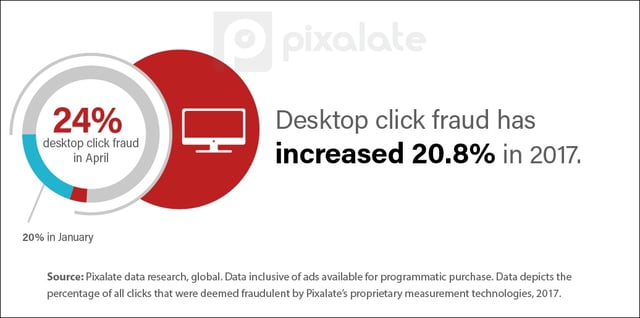
Digital marketers have been trying to escape "click-based" metrics for years, but nonetheless, click-through rate (CTR) numbers still show up on campaign reports. But while the ad world debates the merits of click-based metrics as an effective measurement tool, the affect of click fraud is often overlooked. Just how impactful is click fraud in programmatic?
Pixalate is beginning a series of blog posts which will examine click fraud metrics to identify trends, patterns, and key takeaways for the entire industry. Up first: Desktop click fraud rates.
Click fraud is a growing problem on desktop devices, across all channels (video, display, web, apps, etc.).

The digital ad industry started off 2017 with roughly one-in-five (19.9%) desktop clicks proving fraudulent, and already that number has risen to nearly one-in-four (24.1%).
If desktop click fraud continues to grow at this pace, then over one-third of desktop clicks will be fraudulent by the end of 2017.
Pixalate uncovered a similar trend when examining just desktop display web click fraud rates.
.jpg?width=640&name=click-fraud-display-web-in-1st-quarter-of-2017-v2-copy-(1).jpg)
Our data indicates that click fraud is not just a problem across desktop display ads — it's a fast-growing problem, particularly for desktop display ads on the web. Marketers have already seen click fraud rise from a one-in-five to a one-in-four problem in the span of just a few months.
*By entering your email address and clicking Subscribe, you are agreeing to our Terms of Use and Privacy Policy.
These Stories on Thought Leadership
*By entering your email address and clicking Subscribe, you are agreeing to our Terms of Use and Privacy Policy.

Disclaimer: The content of this page reflects Pixalate’s opinions with respect to the factors that Pixalate believes can be useful to the digital media industry. Any proprietary data shared is grounded in Pixalate’s proprietary technology and analytics, which Pixalate is continuously evaluating and updating. Any references to outside sources should not be construed as endorsements. Pixalate’s opinions are just that - opinion, not facts or guarantees.
Per the MRC, “'Fraud' is not intended to represent fraud as defined in various laws, statutes and ordinances or as conventionally used in U.S. Court or other legal proceedings, but rather a custom definition strictly for advertising measurement purposes. Also per the MRC, “‘Invalid Traffic’ is defined generally as traffic that does not meet certain ad serving quality or completeness criteria, or otherwise does not represent legitimate ad traffic that should be included in measurement counts. Among the reasons why ad traffic may be deemed invalid is it is a result of non-human traffic (spiders, bots, etc.), or activity designed to produce fraudulent traffic.”

